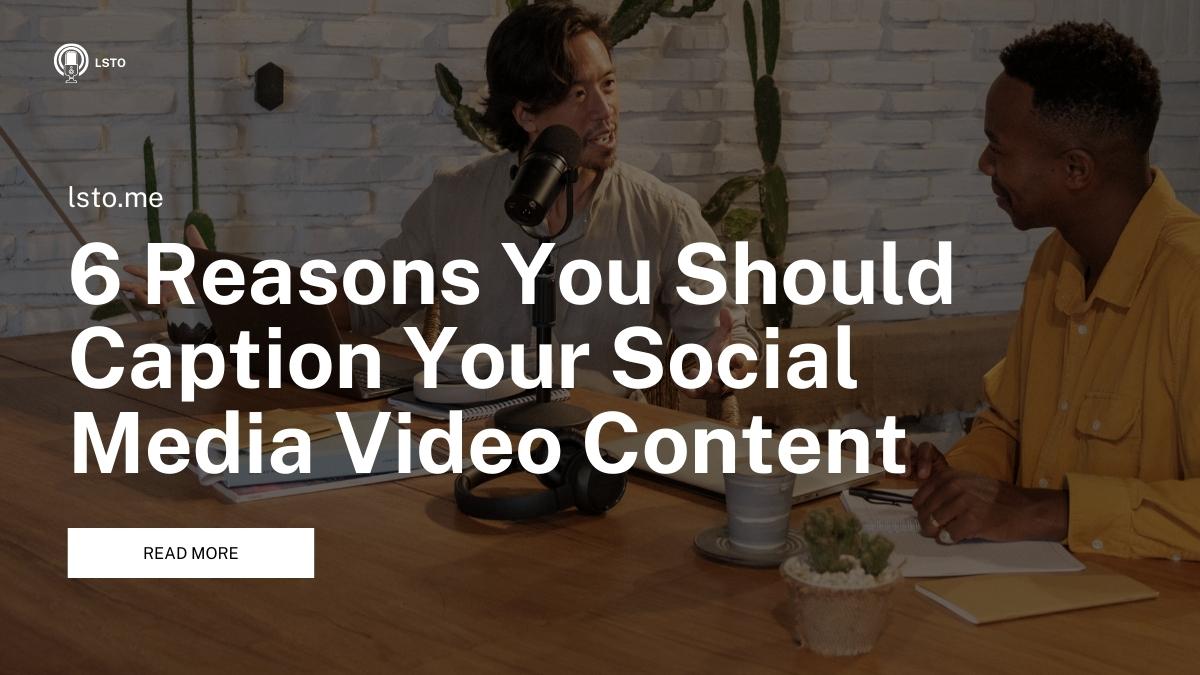
Are you looking for ways to increase engagement with your video content on social media? Did you know that adding captions to your videos can significantly boost their visibility and reach? Understanding how to effectively use captions can be an invaluable tool in driving viewers to your content. In this article, we’ll examine 6 reasons why you should caption your social media video content.
1. Google can’t watch videos, but it can crawl captions
Video content has become a key component for businesses to engage with customers on social media platforms. But, how can you ensure that your videos are seen by the largest audience possible? Reason You Should Caption Your Social Media Video:
Google, the world’s most popular search engine, is unable to watch video content. Instead, it crawls text to determine what a video is about. By adding captions to your videos, you are providing Google with accessible information about your content which will help increase its visibility in search results and make it easier for potential viewers to find your videos.
The bonus of captioning goes beyond SEO benefits; captions also make sure that everyone can access and understand your content regardless of disability or language barrier. Captions have been proven to increase engagement with videos as well as improve comprehension levels by up to 36%.
2. Video captions drive more social engagement
Video captions are becoming increasingly important for social media engagement. No longer just a convenient way to watch videos without sound, captioning can give you an edge when it comes to driving viewer interaction. Here are some of the reasons why captions should be part of your social media video strategy:
First and foremost, captions make your content more accessible to a wider audience. Captions allow those who may be hard of hearing or deaf to understand what’s going on in the video, as well as enable people whose first language isn’t English to still comprehend the content. This not only helps create an inclusive environment but also allows you to reach more viewers and get more engaging responses from them.
3. A lot of people don’t (or can’t) turn on video sound
We live in an age where videos are a major source of entertainment and education. But, with many people watching them without sound, we must caption our social media videos to ensure everyone can enjoy them. Whether it’s due to accessibility or personal preference, a lot of people don’t (or can’t) turn on video sound. That’s why adding captions or subtitles is essential for viewers who have hearing impairments, or simply prefer the convenience of consuming content without sound.
Captions also make your social media posts more accessible to international audiences by including translations in different languages. Not only does this improve the overall user experience for viewers from all over the world, but it also shows that you care about your diverse audience base and want everyone to be included.
4. Captions boost comprehension, memory, and attention
Captions are a powerful tool for getting the most out of social media videos. They boost comprehension, memory, and attention and provide an opportunity to engage with viewers in ways that would otherwise be impossible. Here are some of the main reasons you should make sure to caption your social media videos:
First off, captions help viewers comprehend what’s being said in a video by providing visual cues for any audio elements. This can be especially beneficial for people who have hearing loss or for those who might not understand certain accents or speech patterns. Additionally, captions allow viewers to fully concentrate on the content without having to worry about deciphering what’s being said – which helps them pay more attention and remember more information from the video overall.
5. Captions make videos more inclusive and accessible
Captions make videos more inclusive and accessible for everyone, regardless of hearing ability or language preference. It is becoming increasingly important to consider captioning your video when you post on social media platforms.
There are many reasons why captioning your social media video should be a priority. Firstly, captioning can increase the reach of your content by allowing access to those with hearing impairments, as well as those who have their volume turned off or are in an environment where sound cannot be heard. Secondly, subtitles or captions can also offer translation into multiple languages and make it easier for people from all backgrounds to understand the message you’re trying to convey. Lastly, captions also allow viewers to better engage with the content; they can follow along with more ease and attention if they don’t constantly need to rewind or pause to catch what was said onscreen.
6. Most of your viewers likely live outside of your country of origin
For content creators, it is important to remember that their audience is a global one. In today’s world, most of your viewers will likely live outside of your country of origin. For this reason, it is essential to caption all social media videos created for any given platform. Doing so will ensure that no matter what language a viewer speaks they can understand the message you are trying to convey in the video.
Captioning social media videos allow content creators to reach a much broader audience and expand the number of people who view their work. Additionally, captioning videos makes them more accessible for those who may have difficulty hearing or understanding spoken English. This is especially important when producing educational material or providing instructions that need to be clearly understood by viewers across multiple countries and cultures.
A word of caution: Resist the urge to DIY your captions and subtitles
Creating captions and subtitles for your social media video might seem like a small task, but it should not be taken lightly. Many people are tempted to DIY their captions and subtitles, believing it will save time and money. However, this would be a mistake. There are several reasons why you should resist the urge to create these elements yourself.
First of all, adding captions or subtitles is more than just writing a text on the screen. You need to consider font size, style, and color for the words to be visible without distracting from the video itself. Furthermore, you must make sure that your captions or subtitles do not overlap with any essential images or other text already on the screen. Doing this right requires skill and expertise – something that only professionals can provide.





One Comment